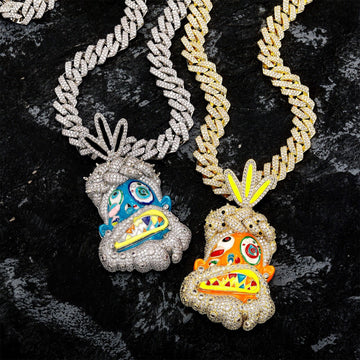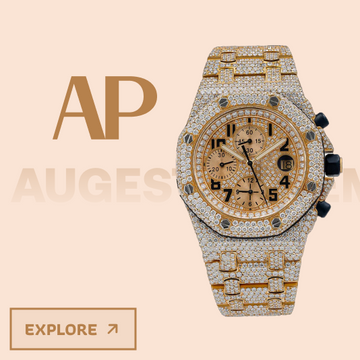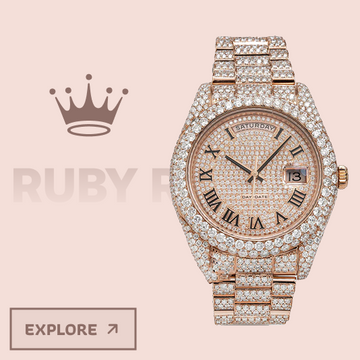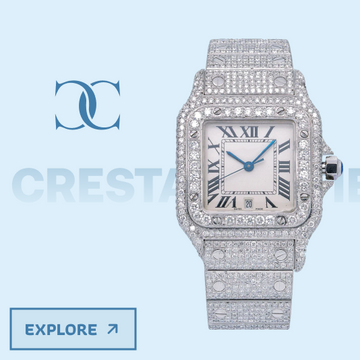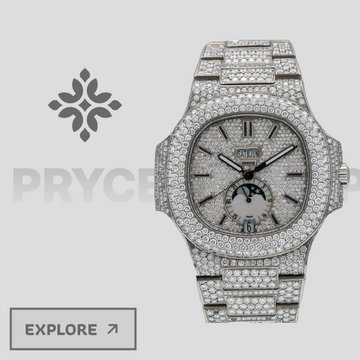Owning a Rolex has never just been about keeping time—it’s about carrying a legacy on your wrist. It means to most of them success, sophistication, and a lifestyle that a small number of people can afford. Put those diamonds up there on top of that heritage, and the watch becomes a timepiece that doubles up as a work of art.
Rolex has a firm standing in the luxury watch market, which is not overly crowded. A Rolex watch is a universal status and style icon due to unparalleled craftsmanship and design, and its legacy. However, not everything that glitters is made equal with diamonds. Some Rolexes are sold with diamonds, which are both factory-set and hand-selected and set by Rolex gemologists themselves; the rest of the models are later upgraded with aftermarket settings. They both are beautiful, and they have extremely different connotations concerning authenticity, value, and investment.
What is a Factory Diamond Rolex?
When Rolex inlays diamonds into a watch at the factory, each stone passes the same stringent quality test as the movement. Rolex only uses the top 0.02 percent of natural diamonds. All of the stones are chosen by hand and fitted in by the in-house gemologists and are perfectly aligned, brilliant, and secure.
- The Datejust, Day-Date (the President), Daytona, and Pearlmaster are models that have factory diamonds.
- Types of settings include diamond hour marks on the dial, full pavé-set cases, and bezels.
- The quality of Rolex is never compromised; every stone is graded to be of superior clarity and color, usually D to G.
A Rolex factory diamond has not just the Rolex brand but a promise of gemological perfection. It is that authenticity that enhances the interest of these watches to collectors.
What is an Aftermarket Diamond Rolex?
An aftermarket diamond Rolex is any Rolex that is later customized with diamonds by a third party since leaving the factory. The bezel of a bracelet, dial, or even a pavéd watch can have the jewels added, and a jeweller or a bespoke watch shop can have the watch iced out.
Why do people choose aftermarket customization?
- To have a more striking, fully jeweled look than the factory models offer.
- To make it more personal, to make it unique as compared to standard catalog watches.
- To have luxury styling at what could become a cheaper price point than Rolex factory gem-setting.
However, aftermarket modifications come with trade-offs:
- Warranty issues: Rolex rescinds warranties when unauthorized diamonds are added.
- Resale value: Aftermarket watches tend to fetch lower prices from collectors because originality is important in the watch industry.
- Quality concerns: Some jewellers use the best quality stones, others, however, might use the cheapest quality of jewels, which will influence the value and the look of the watch.
Even an aftermarket diamond Rolex would still be gorgeous, but customers would be advised to think before they buy, particularly in the interest of a long-term investment.
Rolex Factory Diamonds vs Aftermarket Diamonds: Key Differences
Comparing a factory diamond Rolex and an aftermarket diamond Rolex, there are several factors explaining why factory-set models are more valuable and taken seriously.
Craftsmanship and Setting Quality
- Factory: The diamonds are hand-picked by hand and placed with great precision under a microscope. Rolex gemologists make sure that every stone fits perfectly into the case/dial.
- Aftermarket: It is a jeweler dependent on quality. Even experienced craftsmen may produce a good output; however, the quality of lower-level adjustments may feature imbalanced positions, wrongly fitting stones, or glue.
Diamond Quality
- Factory: Rolex selects diamonds with exceptional clarity (IF–VVS) and near-colorless grades (D–G).
- Aftermarket: Stones can range from premium to commercial-grade, depending on the customer’s budget.
Value Retention
- Factory: Retains or enhances value over a period of time. A factory sapphire and diamond Daytona Rainbow sold at auction for over $500,000--evidence of its desirability.
- Aftermarket: This usually loses value at resale since collectors value originality.
Warranty and Service
- Factory: Entirely under Rolex warranty and subject to service in Rolex Service Centers.
- Aftermarket: Rolex refuses service; warranty is void. Independent watchmakers must be used by the owners.
Risk Factors
- Aftermarket corrections may include defenestration, reduction of structural integrity, or reduction of water resistance.
- Untrained jewelers can break the case or dial when fitting the stones, and this will forever diminish the value of the watch.
Factory vs Aftermarket Diamond Rolex: Comparison Table
|
Aspect |
Factory Diamond Rolex |
Aftermarket Diamond Rolex |
|
Craftsmanship & Setting |
Diamonds that Rolex gemologists have positioned using a microscope with flawless precision. |
Varies with the jeweler- can have irregular settings, glue spots or lack thereof, or stones in disalignment. |
|
Diamond Quality |
Extraordinary transparency (IFVVS) and almost colorless (D-G). |
Prices of high to low, depending on the jeweler. |
|
Value Retention |
Gains or retains the value. Examples Rolex Daytona Rainbow matted at auction at $500,000+. |
In many cases, diminishes the resale value as originality is lost. |
|
Warranty & Service |
Rolex warranty and service in Rolex centers. |
Rolex diswarrants warranty; has to use third-party watchmakers. |
|
Risk Factors |
None, no structural risk; made to Rolex standards. |
Modifications can undermine water resistance, harm components, or decrease longevity. |
Although aftermarket diamond Rolex watches can be customized and inexpensive, Rolex diamond watches set by the factory cannot be compared with other watches in terms of their craftsmanship, investment value, and long durability.
Spotlight on Popular Rolex Diamond Models
Rolex has created some of the most popular diamond-set watches in the world, and all of them have been a mixture of technical expertise and the art of jewelry. Since time immemorial to burnt necklaces, these models demonstrate why factory diamond Rolexes are in a league of their own.
Rolex Datejust with Diamonds
Datejust is among the most multifaceted models of Rolex. Most factory models have diamond hour hands or bezels. It is an excellent choice, every day luxurious, and is classified by its traditional design and modest diamonds.
Rolex Day-Date “President” with Diamonds
The Day-Date, commonly known as the President, usually comes with factory diamond dials, bezels, and even full pave cases. This is a model worn by celebrities, politicians, and world leaders and can be regarded as a timeless symbol of power and authority.
Rolex Pearlmaster
The most jewelry-oriented Rolex line is the Pearlmaster. These are models that are preset with diamonds, sapphires, and rubies. The Pearlmaster bracelet is even frequently gem-set, the artistry of Rolex at an absolute zenith.
Rolex Daytona Rainbow
The Daytona Rainbow perhaps is the most renowned gem-set Rolex and has a bezel of sapped rainbow-colored sapphires as well as diamond-set lugs and dials. Astonishing prices are achieved at auction with factory versions of this watch frequently selling above $400,000-600,000. There are aftermarket versions, but they are valued at a much lower price, which emphasizes the role of factory authenticity.
Rolex Customization: A Growing Trend
Rolex customization has gone viral in spite of its possible disadvantages. Several consumers desire a watch that is indicative of individual preferences, and the aftermarket gems offer unlimited design capability.
Popular Customization Options
- Diamond bezels and dials in unique patterns
- Colored gemstones (sapphires, rubies, emeralds)
- Fully “iced-out” cases and bracelets
- Personalized engraving alongside diamond settings
Celebrity & Cultural Influence
The iced-out Rolex has evolved into a symbol of success and uniqueness in hip-hop and pop culture. The watch is a popular piece with artists, athletes, and businesspersons who often display the custom Rolex watches, which create pressure on the aftermarket.
Although customization is not warmly received by vintage collectors, it is unquestionably defining the contemporary Rolex market.
Value & Investment Perspective
In the case of Rolex and diamonds, sparkle means little in terms of value. Pieces with pre-setting are considered long-term investments, whereas aftermarket models usually have to compromise beauty with lower costs and personal trends.
Factory Diamond Rolexes as Investments
The Rolex diamond watches that are made in factories always command high auction prices. For example:
- An international Rolex Pearlmaster 39 with factory-set diamonds sold at auction for more than $90,000.
The Rainbow Daytona, which used to sell below $100,000, is now selling 5-6 times on the secondary market.
Aftermarket Diamond Rolexes in the Market
Although the aftermarket watches do not get the same prices, they get niche buyers. Certain customers are not as obsessed with originality as much as they are with appearance. A completely iced-out Submariner can be much cheaper than a factory gem-set counterpart, and will appeal to fashion-conscious customers.
Case Study: Value Depreciation
- A factory diamond Rolex Datejust that is sold for $20,000 can be sold again for $18,000 to $22,000, depending on the demand.
- Even a beautifully customized aftermarket diamond Rolex Datejust will only be able to fetch a price of between $12,000 and $15,000, with a clear depreciation.
How to Tell if a Rolex Diamond Watch is Factory or Aftermarket
Authenticity is important to anyone who purchases a Rolex diamond watch. Here’s how to differentiate:
1. Papers and reference numbers: Factory diamond Rolexes have reports that it is authentic.
2. Setting precision: Rolex diamonds are very precise and uniform; any off-the-shelf setting can appear jagged.
3. Authorized Dealer verification: A Rolex AD or approved watchmaker may be able to verify whether stones are factory-set.
4. Price point: When the price looks too good to be true, the diamonds are not likely natural.
Should You Buy a Factory or Aftermarket Diamond Rolex?
The difference between a factory and an aftermarket diamond Rolex is up to you and what you hold in high regard. It is authenticity and long-term investment to some, and individuality and radical customization to others.
Factory Diamond Rolex is best for:
- Collectors seeking investment value
- Buyers who want assurance of quality and authenticity
- Those looking for timeless prestige
Aftermarket Diamond Rolex is best for:
- Style enthusiasts who prioritize looks over resale value
- Buyers wanting a fully iced-out design not offered by Rolex
- Those seeking customization at a lower entry cost
In the finality, it all depends on whether you will consider your Rolex as an investment or as a form of statement.
Final Thoughts – Why Rolex Diamond Watches Stand Out
A Rolex diamond watch, factory-set or aftermarket, is the most prestigious of all. Rolex has a strict set of standards that are mirrored in factory diamonds, and the customization of its products can be done with aftermarket options that permit one to express oneself and be creative.
The two routes glorify luxury, although they have different targets. Diamond Rolexes made in factories are king to the purists and investors. To fashionistas and trendiest wearers, fake diamonds have the glitz and uniqueness.
Regardless of what you pick, there is one thing that will always be true and that is a Rolex diamond watch will never just be a timepiece, but a representation of status, style, and success.
FAQs
What is the difference between a factory diamond Rolex and an aftermarket diamond Rolex?
A factory diamond Rolex comes directly from Rolex with diamonds set by the brand’s master gemologists. An aftermarket diamond Rolex has diamonds added later by a third party. While factory models hold higher resale and collector’s value, aftermarket ones offer more customization and often come at a lower cost.
Do aftermarket diamond Rolex watches lose value?
Typically, yes. Aftermarket diamond Rolex watches do not hold the same resale or collector’s value as factory-set models. Buyers should consider them as luxury fashion statements rather than investment watches.
How can I tell if a Rolex has factory diamonds?
Rolex watches that are manufactured in the factory use Rolex-certified diamonds, which have been cut, have a clear picture, and are set by the brand to strict standards. Find paperwork, Rolex reference numbers, and Rolex authentication. Unofficial settings can be flashy and uncertified by Rolex.
Why are aftermarket diamond Rolex watches cheaper?
There are aftermarket diamond Rolex watches, which tend to be cheaper as diamonds and settings are not certified by Rolex. This gives the option of custom iced-out designs but compromises on resale value and brand authenticity.
Can aftermarket diamonds damage a Rolex watch?
The aftermarket diamonds might not be installed properly, which might compromise the structural integrity and the water resistance of the watch. Whenever you want to get aftermarket, make sure you go to a reputable jeweler.
Do factory diamond Rolex watches come in iced-out styles?
No. Rolex maintains its designs simple and sophisticated. You will need a customization, aftermarket, to have a full-iced-out Rolex with pavé diamonds.
Is it easier to sell a factory or an aftermarket diamond Rolex?
It is much easier to sell a factory diamond Rolex because the collectors and luxury buyers demand the authentic Rolex diamond watch. Only fashion-conscious, ice cream lovers would be attracted to an aftermarket diamond Rolex.
Should I buy a factory diamond Rolex or an aftermarket one?
Purchasing an actual Rolex factory diamond signal of authenticity, heritage, and profitability. Select an aftermarket diamond Rolex when you desire personalized modification and high-end fashion at a reduced point of entry.














